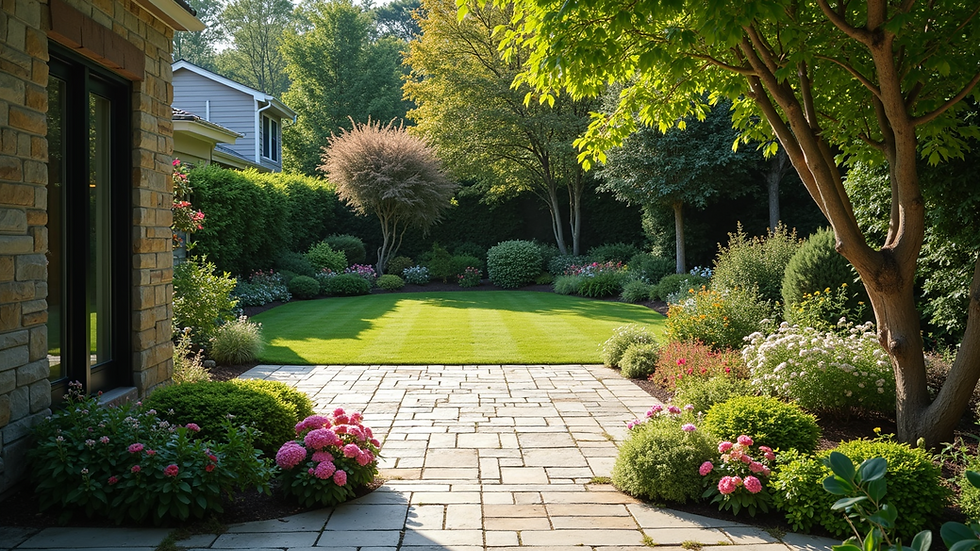Exploring Durable Hardscaping Options for Your Outdoor Space
- Gardenturtle
- Aug 20
- 4 min read
Creating an outdoor space that is both beautiful and long-lasting requires careful planning and the right materials. Hardscaping solutions offer a fantastic way to enhance your garden, patio, or yard with structures and surfaces that stand the test of time. From patios and walkways to retaining walls and fire pits, durable hardscaping can transform your outdoor area into a functional and inviting environment.
Choosing the right hardscaping materials is essential for durability, aesthetics, and maintenance. This article explores various hardscaping options, their benefits, and practical tips to help you make informed decisions for your outdoor space.
Durable Hardscaping Solutions to Consider
When selecting hardscaping solutions, durability is key. You want materials that can withstand weather changes, foot traffic, and time without losing their charm. Here are some popular and durable options:
1. Concrete
Concrete is one of the most versatile and durable hardscaping materials available. It can be poured into any shape, stamped with patterns, or stained to mimic natural stone or brick. Its strength makes it ideal for driveways, patios, and walkways.
Pros: Long-lasting, low maintenance, customizable finishes.
Cons: Can crack over time if not properly installed or maintained.
For a modern and clean look, consider exposed aggregate concrete, which reveals small stones on the surface for texture and slip resistance.

2. Natural Stone
Natural stone such as granite, slate, or limestone offers timeless beauty and exceptional durability. Stones are available in various shapes and sizes, allowing for creative layouts in patios, pathways, and retaining walls.
Pros: Unique appearance, weather-resistant, adds value to your property.
Cons: Can be expensive, requires professional installation.
Using natural stone can create a rustic or elegant atmosphere depending on the stone type and arrangement.
3. Brick
Brick is a classic hardscaping material that provides warmth and character. It is durable and can be laid in different patterns like herringbone or basket weave to add visual interest.
Pros: Durable, easy to repair, traditional look.
Cons: Can be prone to moss growth in damp climates, requires sealing.
Bricks are excellent for garden paths, patios, and edging.

4. Pavers
Pavers are manufactured blocks made from concrete, clay, or stone. They come in various shapes, sizes, and colors, making them highly versatile for patios, driveways, and walkways.
Pros: Easy to install and replace, slip-resistant, wide design options.
Cons: Weeds can grow between joints if not sealed properly.
Interlocking pavers are especially popular for their strength and ease of maintenance.
5. Gravel
Gravel is an affordable and easy-to-install option for pathways and driveways. It allows for excellent drainage and can be combined with other materials for a layered look.
Pros: Cost-effective, good drainage, easy to replenish.
Cons: Can scatter over time, requires edging to keep in place.
Gravel works well in informal or rustic garden designs.
What is an example of a landscape?
A landscape typically combines both softscaping and hardscaping elements to create a cohesive outdoor environment. For example, a backyard might feature a stone patio surrounded by lush flower beds, a gravel pathway leading to a wooden pergola, and a retaining wall made of natural stone to manage elevation changes.
This combination balances aesthetics and functionality, providing spaces for relaxation, entertainment, and gardening. The hardscaping elements provide structure and durability, while the softscaping adds color, texture, and life.

Tips for Choosing the Right Hardscaping Materials
Selecting the best hardscaping materials depends on several factors. Here are some practical tips to guide your decision:
Consider Climate and Weather
Materials should be able to withstand local weather conditions. For example, freeze-thaw cycles can cause cracking in some stones or concrete if not properly installed. In hot climates, lighter-colored materials can reduce heat absorption.
Match Your Home’s Style
Choose materials that complement your home’s architecture and color palette. For a modern home, sleek concrete or large pavers might work best. For a cottage-style home, natural stone or brick can enhance the charm.
Think About Maintenance
Some materials require more upkeep than others. Concrete and pavers generally need less maintenance, while natural stone may require sealing. Gravel needs periodic replenishing and edging.
Budget Wisely
Hardscaping can be a significant investment. Balance your budget with the desired look and durability. Sometimes combining materials, like a concrete base with stone accents, can provide a cost-effective yet attractive solution.
Plan for Functionality
Consider how you will use the space. High-traffic areas need more durable surfaces. If you want an outdoor kitchen or fire pit, materials must be heat-resistant and easy to clean.
Enhancing Your Outdoor Space with Professional Hardscaping
While DIY projects can be rewarding, professional hardscaping services ensure quality installation and long-term durability. Experts can help with:
Site assessment and design tailored to your needs.
Proper base preparation to prevent shifting and cracking.
Selecting materials that suit your climate and style.
Incorporating drainage solutions to avoid water damage.
For those interested in expert advice and quality materials, exploring landscaping services can provide valuable insights and options.
Final Thoughts on Durable Hardscaping Solutions
Investing in durable hardscaping solutions can significantly enhance your outdoor living experience. By choosing the right materials and design, you create a space that is not only beautiful but also functional and long-lasting. Whether you prefer the natural elegance of stone, the classic appeal of brick, or the versatility of concrete and pavers, there are options to suit every taste and budget.
Remember to consider climate, maintenance, and your lifestyle needs when planning your hardscape. With thoughtful planning and professional help, your outdoor space can become a stunning retreat that adds value and enjoyment for years to come.



Comments